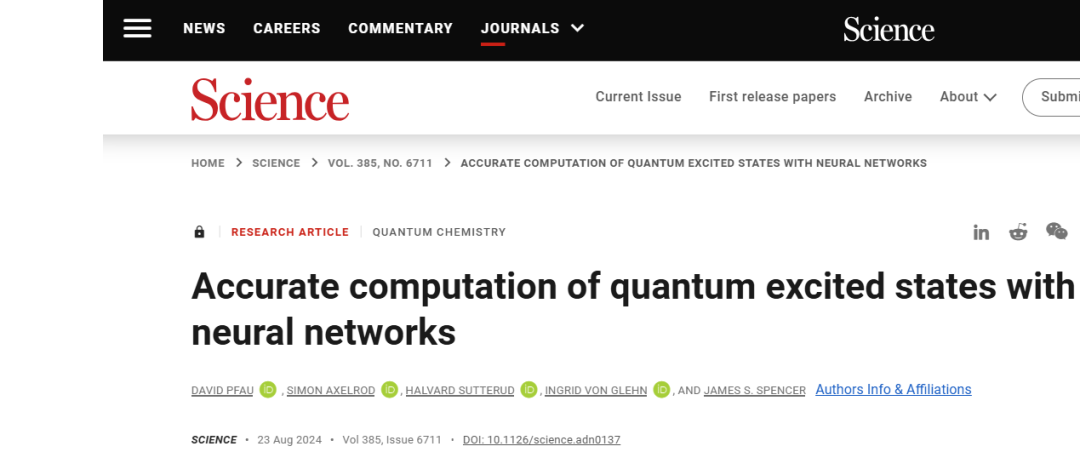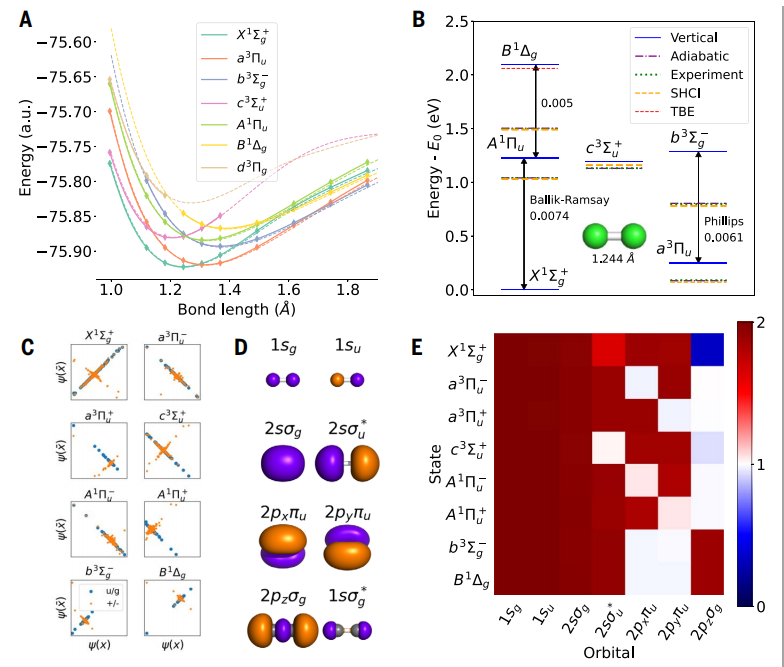

Editor | KX
Previously, the fermion neural network (FermiNet) developed by Google DeepMind researchers is very suitable for modeling the quantum ground state of a large number of electrons.
FermiNet initially focused on the ground state of molecules. But when molecules and materials are stimulated by large amounts of energy, such as when exposed to light or high temperatures, electrons can be kicked into a higher energy state - an excited state.
Excited states are important in fields such as physics and chemistry; however, scalable, accurate, and robust calculations of excited state properties from first principles still face important theoretical challenges.
Now, DeepMind researchers have developed a new method for calculating excited states that is more powerful and versatile than previous methods. The method can be applied to any type of mathematical model, including FermiNet and other neural networks.
The proposed method achieves accurate excited state calculations for many atoms and molecules, is far superior to existing methods of using deep learning to calculate excited state properties (especially on larger systems), and can be applied Various quantum systems.
David Pfau, the first author and corresponding author of the paper, excitedly published "This is the first time that deep learning has accurately solved some of the most difficult problems in quantum physics. We hope to take a new step towards universal quantum simulation of deep learning."

Relevant research titled "Accurate computation of quantum excited states with neural networks" was published onScience!

Paper link:https://www.science.org/doi/abs/10.1126/science.adn0137
Molecular excited states
When molecules and materials are stimulated by large amounts of energy, e.g. Exposed to light or high temperatures, their electrons are kicked into a temporary new structure called an excited state.
The exact amount of energy absorbed and released by a molecule as it transitions between states creates a unique fingerprint for different molecules and materials. This affects the performance of technologies ranging from solar panels and LEDs to semiconductors and photocatalysts. They also play a key role in biological processes involving light, including photosynthesis and vision.
However, this type of fingerprint is extremely difficult to model because the excited electrons are quantum in nature, meaning that their position in the molecule is never certain and can only be represented by probabilities.
FermiNet can produce highly accurate, and in some cases state-of-the-art, ground state energies in a range of atoms and small molecules with a variety of qualitative positron binding properties.
However, FermiNet initially focused on the ground state of molecules. But when molecules and materials are stimulated by large amounts of energy, such as when exposed to light or high temperatures, electrons can be kicked into a higher energy state - an excited state.
Accurately calculating the energy of the excited state is much more difficult than calculating the energy of the ground state. Even gold-standard methods of ground-state chemistry, such as coupled clusters, show tens-fold errors in excited states. While the researchers wanted to extend their work on FermiNet to excited states, existing methods did not perform well enough to make neural networks comparable to state-of-the-art methods.
A more powerful and versatile new method for excited state calculation
DeepMind proposes an algorithm for estimating excited states of quantum systems through variational Monte Carlo. This algorithm has no free parameters and does not require orthogonalization of states. ization, but transform the problem into the problem of finding the ground state of the extended system. Arbitrary observables can be calculated, including off-diagonal expectations such as transition dipole moments.
This method is particularly suitable for neural network analysis. By combining this method with FermiNet and Psiformer ansatz, it is possible to accurately recover the excitation energies and oscillator strengths of a series of molecules.

Illustration: Excited state energies of the first row of atoms from lithium to neon. Results of NES-VMC applied to FermiNet. (Source: paper)
The researchers combined the flexibility of neural networks ansätze with mathematical insight, allowing them to transform the problem of finding the excited state of a system into the problem of finding the ground state of an extended system, which can then be solved using standard VMC. This method is called naturally excited state VMC (NES-VMC).
Linear independence of excited states is automatically imposed via the functional form of ansatz. The energy of each excited state and other observables are obtained by diagonalizing the Hamiltonian expectation value matrix on the singlet ansätze, and these observables can be accumulated at no additional cost.
Entscheidend ist, dass diese Methode keine freien Parameter zum Anpassen und keinen Strafterm zum Erzwingen der Orthogonalisierung hat. Die Forscher untersuchten die Genauigkeit dieses Ansatzes mithilfe zweier unterschiedlicher neuronaler Netzwerkarchitekturen: FermiNet und Psiformer.
Von einzelnen Atomen zu Benzol
Die Forscher testeten ihre Methode an einem Benchmark-System, das von einzelnen Atomen bis zu Molekülen in Benzolgröße reicht. Es wurde bestätigt, dass die Genauigkeit von NES-VMC bei Atomen der ersten Reihe den experimentellen Ergebnissen sehr nahe kommt, und bei einer Reihe kleiner Moleküle werden hochpräzise Energien und Schwingungen erhalten, die mit den besten vorhandenen theoretischen Schätzungen der Gerätestärke vergleichbar sind.

Abbildung: angeregter Zustand des Kohlenstoffdimers. (Quelle: Paper)
Erzielte einen mittleren absoluten Fehler (MAE) von 4 meV bei einem kleinen, komplexen Molekül namens Kohlenstoffdimer, was fünfmal genauer ist als frühere Goldstandardberechnungen.

Abbildung: angeregte Zustände und konische Schnittpunkte von Ethylen. (Quelle: Papier)
Im Fall von Ethylen beschreibt NES-VMC die konischen Schnittpunkte des verdrillten Moleküls korrekt und stimmt gut mit den hochpräzisen Ergebnissen der Multiple Reference Configuration Interaction (MR-CI) überein.

Abbildung: Angeregte Zustände eines größeren Doppelerregungssystems. (Quelle: Papier)
Die Studie berücksichtigte auch fünf anspruchsvolle Systeme mit tiefliegenden Doppelanregungen, darunter mehrere Moleküle der Benzolklasse. In einem System, in dem alle Methoden eine gute Übereinstimmung hinsichtlich der vertikalen Anregungsenergien aufweisen, ist Psiformer in allen Zuständen chemisch genau, einschließlich Butadien, dessen Reihenfolge einige von ihnen ebenfalls seit Jahrzehnten umstritten ist.
Für Tetrazine und Cyclopentadienone, bei denen hochmoderne Berechnungen von vor einigen Jahren bekanntermaßen ungenau sind, stimmen die NES-VMC-Ergebnisse nicht mit der jüngsten hochentwickelten Monte-Carlo-Diffusion (DMC) und vollständig aktiven Raumstörung dritter Ordnung überein Die Berechnung der Theorien (CASPT3) liegt sehr nahe.

Abbildung: angeregter Zustand von Benzol. (Quelle: Papier)
Schließlich wurde auch das Benzolmolekül untersucht, wobei NES-VMC in Kombination mit dem Psiformer-Ansatz im Vergleich zu anderen Methoden, einschließlich des neuronalen Netzwerkansatzes unter Verwendung der Strafkonsistenz, bessere Ergebnisse lieferte. Dies bestätigt nicht nur die mathematische Korrektheit der vorgeschlagenen Methode, sondern zeigt auch, dass neuronale Netze die angeregten Zustände von Molekülen an den Grenzen aktueller Rechenmethoden genau darstellen können.
Wie man es in Zukunft auf die Vielteilchen-Quantenmechanik anwenden kann
NES-VMC ist ein parameterfreies und mathematisch fundiertes Prinzip der Variation angeregter Zustände. Kombiniert man dies mit neuronalen Netzwerkansätzen, kann bei einer Vielzahl von Benchmark-Problemen eine erhebliche Genauigkeit erreicht werden.
Genaue VMC-Methoden für angeregte Zustände von Quantensystemen eröffnen viele Möglichkeiten und erweitern den Anwendungsbereich neuronaler Netzwerkwellenfunktionen erheblich.
Obwohl diese Studie nur elektronische Anregungen molekularer Systeme und neuronale Netzwerkansätze berücksichtigte, ist NES-VMC auf jeden Quanten-Hamiltonianer und jeden Ansatz anwendbar und ermöglicht präzise rechnerische Studien, die das Verständnis der Wissenschaftler für die elektronische Schwingungskopplung und das optische Bandverständnis verbessern können Lücken, Kernphysik und andere herausfordernde Probleme.
Die Forscher sagten: „Wir freuen uns darauf, wie NES-VMC und tiefe neuronale Netze in Zukunft auf die anspruchsvollsten Probleme der Vielteilchen-Quantenmechanik angewendet werden.“ /x.com/pfau/status/1826681648597135464
https://deepmind.google/discover/blog/ferminet-quantum-physics-and-chemistry-from-first-principles/
https:// www.imperial .ac.uk/news/255673/ai-tackles-most-difficult-challenges-quantum/
The above is the detailed content of AI solves quantum physics problem for the first time, DeepMind accurately calculates quantum excited states, listed in Science. For more information, please follow other related articles on the PHP Chinese website!




